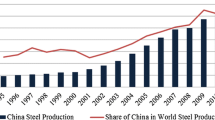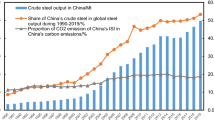Abstract
The master plan of energy management for Thailand iron and steel industry has been proposed by Iron and Steel Institute of Thailand (ISIT). Three plausible scenarios in the master plan were S1: without integrated steel plant (baseline scenario), S2: with a traditional integrated BF–BOF and S3: with an alternative integrated DR-EAF. This study investigated the potential of energy reduction and CO2 emission reduction in 2030 under two reduction target scenarios which were scenario A: to achieve ISIT'S plan and scenario B: maximum energy reduction. Moreover, the CO2 abatement cost curve and the sensitivity analysis of the abatement cost with different interest rates were studied. By following the baseline scenario (S1), the potential of energy reduction and CO2 reduction was 12.74 million GJ and 1.28 million tCOeq. The traditional integrated BF–BOF route (S2) exhibited the highest energy saving and CO2 reduction potential, followed by S3 (DR-EAF) and S1 (baseline). The maximum energy reduction and CO2 reduction could be increased 11.8% and 17.9% from the ISIT’s plan. The sensitivity analysis indicated that the change of interest rates (3.27, 4.27 and 5.27%) affected the abatement cost ranged from − 21 to + 24% when compared with the long-term interest rate of 4.27%.


















Similar content being viewed by others
References
BOI (The Board of Investment of Thailand). (2007, August 8). Thailand investment review. Retrieved from http://www.mda.co.th/jan08/ThaiSteelIndustry.pdf.
Chaichaloempreecha, A., Chunark, P., & Limmeechokchai, B. (2019). Assessment of Thailand’s energy policy on CO2 emissions: Implication of national energy plans to achieve NDC target. International Energy Journal, 19, 47–60.
European Commission. (2013). Best available techniques (BAT) reference document for iron and steel production, Joint Research Centre Institute for Prospective Technological Studies, p 533.
Fan, Y., Zhu, L., & Li, Y. (2016). Potential of CO2 abatement resulting from energy efficiency improvements in China’s iron and steel industry. In B. Su & E. Thomson (Eds.), China’s energy efficiency and conservation (pp. 67–83). Berlin: Springer.
Forbes Custom. (2018, October 31). Thailand: A vision for the future. Retrieved from https://www.forbes.com/custom/2018/10/30/thailand-a-vision-for-the-future/.
Hasanbeigi, A., Arens, M., & Price, L. (2013a). Emerging energy-efficiency and carbon dioxide emissions reduction technologies for the Iron and Steel Industry, Lawrence Berkeley National Laboratory (pp. 1–116).
Hasanbeigi, A., Morrowa, W., Sathaye, J., Masanet, E., & Xu, T. (2013b). Bottom-up model to estimate the energy efficiency improvement and CO2 emission reduction potentials in the Chinese iron and steel industry. Energy, 50, 315–325.
Hea, K., & Wang, L. (2017). A review of energy use and energy-efficient technologies for the iron and steel industry. Renewable and Sustainable Energy Reviews, 70, 1022–1039.
IPCC (The Intergovernmental Panel on Climate Change). (2006). Guidelines for national greenhouse gas inventories: Volume 3 industrial process and product use (pp. 1–30).
ISIT (Iron and Steel Institute of Thailand). (2008). An overview of Thailand’s steel industry. Retrieved from: https://www.set.or.th/th/news/download/files/2551/20080612_Thailand_Steel_Industry.pdf.
ISIT (Iron and Steel Institute of Thailand). (2011, August 18). Overview of Steel Industry in Thailand. Retrieved from: http://www.asiaeec-col.eccj.or.jp/cooperation/2-1-1/2006-2007/thailand-attach/1_1.pdf.
ISIT (Iron and Steel Institute of Thailand). (2012). Master plan of energy management for Thailand Iron and Steel Industry (pp. 8–22).
ISIT (Iron and Steel Institute of Thailand). (2018). Thailand Steel Industry 2018 and Outlook 2019. SEAISI Statistical Committee Meeting, Bangkok, Thailand.
Juntueng, S., Towprayoon, S., & Chiarakorn, S. (2014). Energy and carbon dioxide intensity of Thailand’s steel industry and greenhouse gas emission projection toward the year 2050. Resources, Conservation and Recycling, 87, 46–56.
Kesickia, F. (2001). Marginal abatement cost curves for policy making-expert-based vs. model-derived curves (pp. 1–19). UCL Energy Institute: University College London, London.
Krungsri Research. (2019, March 1). Thailand Industry Outlook 2019–21: Steel Industry. Retrieved from: https://www.krungsri.com/bank/getmedia/9fa1e9ce-7b5f-4191-af82-d4d6041d1914/IO_Modern_Trade_190829_EN_EX.aspx.
Li, Y., & Zhu, L. (2014). Cost of energy saving and CO2 emissions reduction in China’s iron and steel sector. Applied Energy, 130, 606–616.
NIDA (The National Institute of Development Administration). (2010). Study and construct database and models for predicting the long-run Thai economic growth (pp. 195–198).
Okazaki, T., & Yamaguchi, M. (2011). Accelerating the transfer and diffusion of energy saving technologies steel sector experience—Lessons learned. Energy Policy, 39, 1296–1304.
ONEP (Office of Natural Resources and Environmental Policy and Planning). (2015, July 5). Thailand’s intended nationally determined contribution (INDC). Retrieved from: http://www4.unfccc.int/submissions/INDC/Published%20Documents/Thailand/1/Thailand_INDC.pdf.
ONEP (Office of Natural Resources and Environmental Policy and Planning). (2015, December 5). Second biennial update report of Thailand (p. 38).
Persia Metal Company. (2008). Using scrap tires in EAFs as a substitute for carbon. ISSI, 5(1), 36–40.
SEAISI (The South East Asia Iron and Steel Institute). (2018, March 1). Thailand’s, apparent steel demand in the first half of 2018. Retrieved from: http://www.seaisi.org.
US.EPA (U.S. Environmental Protection Agency). (2012). Available and emerging technologies for reducing greenhouse gas emissions from the Iron and Steel Industry (pp. 1–78).
Wang, K., Wang, C., Lu, X., & Chen, J. (2007). Scenario analysis on CO2 emissions reduction potential in China’s iron and steel industry. Energy Policy, 35(4), 2320–2335.
WSA (World Steel Association). (2018, March 1). Steel Fact. Retrieved from: http://www.worldsteel.org/about-steel/steel-facts.html.
Acknowledgements
The authors would like to thank the Iron and Steel Institute of Thailand (ISIT) for some data support and gratefully acknowledge the Joint Graduate School of Energy and Environment (JGSEE), Center for Energy Technology and Environment, Ministry of Education, Thailand and National Research Council of Thailand (NRCT) for the financial support in this study.
Author information
Authors and Affiliations
Corresponding author
Additional information
Publisher's Note
Springer Nature remains neutral with regard to jurisdictional claims in published maps and institutional affiliations.
Rights and permissions
About this article
Cite this article
Juntueng, S., Towprayoon, S. & Chiarakorn, S. Assessment of energy saving potential and CO2 abatement cost curve in 2030 for steel industry in Thailand. Environ Dev Sustain 23, 2630–2654 (2021). https://doi.org/10.1007/s10668-020-00691-4
Received:
Accepted:
Published:
Issue Date:
DOI: https://doi.org/10.1007/s10668-020-00691-4




